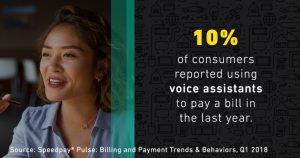
Artificial intelligence (AI), such as voice assistants used in various smart speakers, has exploded in popularity over the past few years, and people across the world are using voice assistants to support a variety of everyday tasks. However, consumers are not widely using this technology for bill payments yet. According to the Speedpay® Pulse, a recently conducted survey of at least 3,000 U.S. adults who are responsible for two or more household payments per month, consumers use voice assistants to play music (29.8%), set an alarm (23.4%), and purchase items online (11.1%). However, only 7.4 percent of consumers reported using a voice assistant to make a credit card payment.
Adoption of Voice Assistants
According to the research, the highest adoption of voice assistants are among young people, but across the board, other generations seem to be taking an interest. Based on our research, the majority of consumers using voice assistants are ages 18-34 with approximately 75 percent of consumers ages 18-22 already using voice assistants and approximately 70 percent of consumers ages 23-34 already using the technology, as well. Unsurprisingly, our research found that only 16 percent of consumers ages 72-80 use voice assistants.
Opportunity vs. Reality
Although there is a preference for voice assistants across all generations, according to our research, the reality is that only 1 in 6 consumers currently own a smart speaker. The research notes that while nearly 30 percent of consumers have used a voice assistant to play music and to complete everyday tasks, consumers are still warming up to voice assistants, as well as mobile app and mobile wallet usage. This means that although it is inevitable voice assistants will eventually greatly impact the way consumers pay their bills, research demonstrates there is still room to grow with only 10.3 percent of consumers reporting using voice assistants to pay a bill in the past year. This is because it is still rare for companies to offer artificial intelligence technologies like voice assistants to pay bills, but that could change soon as this technology becomes more popular.
However, once consumers become more comfortable with voice assistants, there is opportunity for this technology to be fully integrated into the payments process. According to recent data, approximately 22 percent of total consumers reported an interest in paying a bill using a voice assistant and those numbers jumped in the highly-sought-after Millennial (39.5%) and Generation Z (34.2%) demographics.
So, the question remains, what can billers do to help consumers become more comfortable with voice assistants?
Bottom Line: Familiarity is Key
For billers, it is important to invest in digital adoption and mobile optimization, as consumers become more comfortable managing their bill payments in different ways.
As companies educate consumers on different payment channels, they can begin to educate consumers about what voice assistants can offer and how they work. This education will help ensure that once adoption increases, consumers will feel better prepared and comfortable taking advantage of this technology.
To learn more, click here to read the full Speedpay® Pulse research report.









